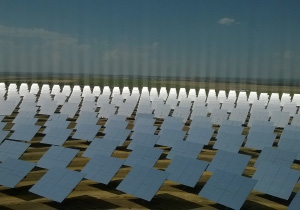Responding to the demand for energy and infrastructure
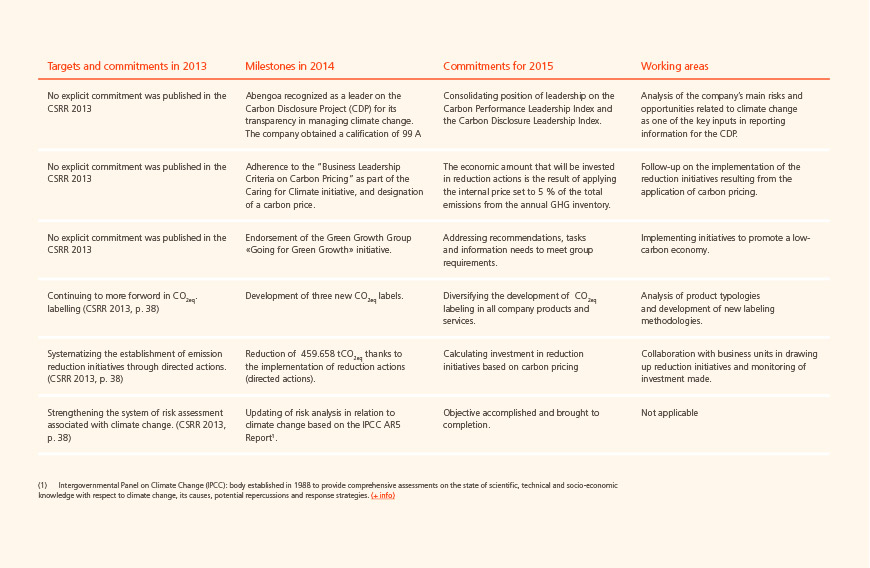
The global demand for infrastructure over the next 15 years is estimated to require an investment of € 57 B, which means an annual average of € 3.2 B1, over three times more than Spain’s GDP. Around 40 % of this investment will target the energy and water sectors, where Abengoa enjoys a presence and conducts its activity , lAnd linked to investment in infrastructure is the rising demand for energy. According to the International Energy Agency (IEA)2, demand will increase by 37 % from now until 20403 .
This chapter of the report describes the manner in which Abengoa responds to the challenges associated with the rising demand for infrastructure and energy and how the company turns these challenges into opportunities by drawing on its business model and R&D and innovation. Abengoa does so under the conviction that the future depends on complete restructuring of the energy model based on the transition to a paradigm based on energy efficiency, energy saving and the use of clean energy sources. This section also provides information on the company’s performance from the standpoint of the energy it uses and the emissions associated with company activity 4.
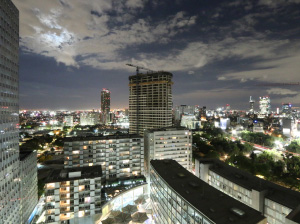
Photograph taken by Daehyun Kim for the 6th Edition of the Sustainability Photography Contest.
Photography contest for employees organized annually by Abengoa. The jury awarded the first prize and up to three runners![]()
Note 1 Unlocking Investment in Infrastructure. Standard and Poor’s, McKinsey; June 2014.
Note 2 International Energy Agency (IEA): international organization dedicated to working to ensure reliable, affordable and clean energy for its member countries through its main areas of focus: energy security, economic development, environmental awareness and engagement worldwide.(+ info)
Note 3 Word Energy Outlook 2014
Note 4 Performance in relation to use and production of water resources is described in detail in the chapter titled «Managing available natural resources».
Main lines of R&D and innovation in the fields of energy
Abengoa is currently engaged in the development of a variety of lines of research in the energy. The company’s aim is to make newly developed technologies marketable in the near future and move them into new market niches. Listed below are the most prominent among these technologies.
Thermal energy storage
Abengoa is working to develop new lines of research into technologies that help lower costs, achieve higher efficiency and enhance the manageability of the company’s solar plants. The commercial thermal storage technologies the company has developed, which continue undergoing research with a view to improvement, are divided into the following types:
- Molten salt storage:
- Indirect: employing a heat exchanger to transfer calorific energy from the fluid that absorbs concentrated solar radiation (thermal oil) to the molten salts (Solana, in Arizona US.).
- Direct: where molten salts directly absorb concentrated solar radiation and store thermal energy in tanks prepared for this purpose (Atacama I, desert of Antofagasta, Chile).
- Steam accumulator: using a thermally insulated tank containing hot water and pressurized steam (Khi Solar One in Upington, South Africa).
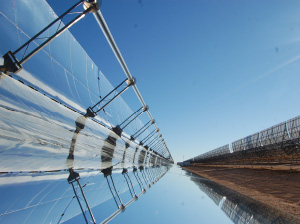
Photograph taken by Abdellah Boujediane for the 6th Edition of the Sustainability Photography Contest.
Photography contest for employees organized annually by Abengoa. The jury awarded the first prize and up to three runners.![]()
Photovoltaic energy
Photovoltaic energy is another of Abengoa’s prominent fields of research.
In 2014, Abengoa continued developing thin film photovoltaic technology, high-concentration (HCPV)5 emonstration high-concentrating photovoltaic technology-based plant was installed in the U.S. (SolarTac in Denver), and a 400 kWp commercial plant was implemented in France- ; with regard to low-concentration photovoltaics (LCPV)6 Abengoa worked throughout 2014 in collaboration with the Fraunhofer Institute, the CSIC7 the University of Seville and the University of Cádiz on concept design and development, and on construction of a functional prototype which is currently being monitored and validated at the Solucar Complex, in Seville (Spain).
Additionally, Abengoa Research is working on solar cells based on perovskite, a material with extraordinary properties that is revolutionizing the field of photovoltaics as the result of its 20 %+ efficiency in converting light into electricity. In carrying out these new projects, Abengoa Research collaborates with institutions and universities that include the École Polytechnique Fédérale de Lausanne, the Max Planck Institute for Polymer Research and the University of Castile-La Mancha.
Note 5 Concentrated photovoltaics (CPV) is a technology that employs lenses, curved mirrors and other types of optical devices to generate electricity by focusing a large amount of sunlight onto the smallest possible number of photovoltaic cells. In comparison with ordinary photovoltaic systems, CPV helps lower costs. High-concentrating (HCPV) systems use optics which concentrate light at an intensity of 1,000 suns or more
Note 6 Low concentration (LCPV) systems have a solar concentration of 2 to 100 suns.
Note 7 CSIC (acronym in Spanish for Spanish National Research Council): largest public institution dedicated to research in Spain and the third largest in Europe; its main objective is to develop and promote research to bring about scientific and technological progress.(+ info)
Power Systems
Abengoa is working on the development of intelligent solar plantsthrough the Smart Solar Plant (SSP) Project. These plants combine solar thermal and photovoltaic technology to achieve optimal integration into the electric system. In addition to generating clean energy with a cheaper tariff, these plants will have the capability to provide support services to the electrical power grid and optimize their share in the most competitive electric markets. To this end, the company is analyzing the impact and viability of these new breeds of power plants in diverse electric scenarios, including the U.S., Chile, South Africa and Germany.
Solar energy 24 hours a day
En 2014 Abengoa fue Abengoa was selected in 2014 by the Ministry of Energy of the Chilean government and the Production Development Corporation (CORFO)8 to develop the largest solar thermal plant in Latin America.This contract award is part of Chile’s national program for the development of renewable energy sources, whose aim is to provide the country with a cleaner energy future. Chile aims to achieve by 2025 the goal of producing through clean energy.
Located in the Atacama Desert, the region that receives the highest concentration of solar radiation in the world, the 110 MW tower technology-based solar plants equipped with 17.5 hours of molten salt thermal energy. This will enable non-stop production of renewable energy 24 hours a day and a 100 MW capacity photovoltaic plant.
Once it has entered into operation, the plant will prevent the emission into the atmosphere of approximately 870,000 tCO2eq per annum, and in addition it will respond to community and industry energy demand thanks to the combination of the two technologies.
Construction, operation and maintenance of this complex will serve as a catalyst for regional and national socioeconomic development, generating an average of 1,100 directs jobs, up to a peak of 2,500. Once the project enters into commercial operation, 60 direct long term positions will be created.
Project construction began in July 2014, and the plant will be ready to go operational in March 2017.
 Reconstruction of the solar project being executed by Abengoa in Chile.
Reconstruction of the solar project being executed by Abengoa in Chile.Note 8 CORFO (acronym in Spanish for Production Development Corporation): Chilean governmental organization tasked with promoting domestic production activity (+ info)

Cristina Cuesta, accesit in the 6th Edition of the Sustainability Photography Contest. El arbol y la luz.
Photography contest for employees organized annually by Abengoa. The jury awarded the first prize and up to three runners.![]()
Biomass
Abengoa develops energy crops9 and works through innovation to improve theenergy productivity of harvested wood products and increase the volume of cultivated energy plantations.
The biomass, pellet10 and wood chip11 , chip market is expected to see significant growth in the next few years to meet the demands from different parts of the world. In order to address these needs, Abengoa already boasts a variety of projects that are at an advanced stage in areas comprising energy plantations, biomass transportation and wood chip and pellet plants.
Risks and opportunities associated with climate change
Abengoa’s business model and strategy are designed around the creation of innovative technology-based solutions for sustainability, where climate change plays an essential role.
For this reason, Abengoa conducts extensive analysis12 of the different aspects associated with climate change, including potential related regulatory or physical changes, with the aim of protecting company assets, contributing to mitigating inherent risks and exploiting potential business opportunities that may arise as a result of this phenomenon.
Note 9 Energy crops: fast-growing plants grown for the purpose of energy production.
Note 10 Pellets: ground forestry biomass that has been dried and compacted to obtain cylinders with a diameter of just a few millimeters and with the lignin contained therein acting as a natural bonding substance for use as biofuels.
Note 11 Wood chips: small pieces of wood obtained by cutting or chipping forest biomass.
Note 12 In 2014, Abengoa revised its methodology for analyzing risks in relation to climate change based on the reflections of the Intergovernmental Panel on Climate Change (IPCC) in its fifth assessment report, which establishes 1.8ºC as the estimate for the low scenario in average temperature rise.
Outlined below are the financial implications of the risks and opportunities linked to climate change and the measures adopted by the company to address the former:
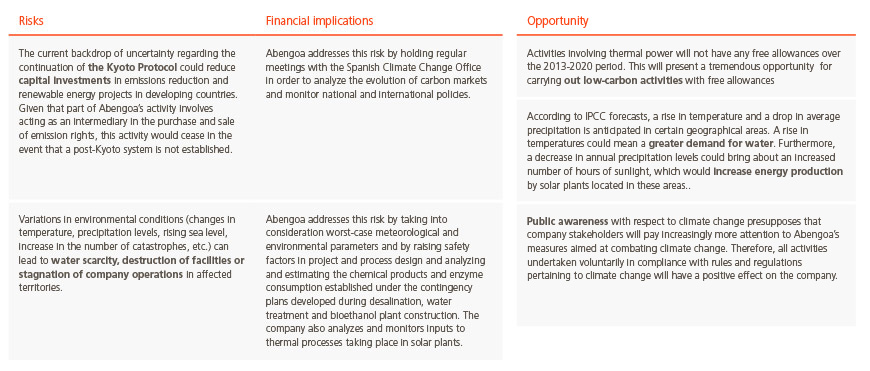



Responsibility in relation to company activities with an impact on climate change
The activity carried out by Abengoa is characterized by its potential influence on the effects occurring from climate change.and therefore the company takes into account all factors involved in the business that may have an impact on our natural surroundings. Keenly aware of its responsibility, Abengoa engages in diverse initiatives contributing to palliating these impacts and which involve each and every area of the organization.
Abengoa’s commitment to sustainable development and halting climate change accordingly extends to include all areas of company activity: including employees, through hours of training dedicated to these areas; the supply chain, by means of the GHG emissions inventory for quantifying the emissions of all of the company’s products and services; customers, through CO2eq labelling to inform the market on the carbon footprint associated with business development; and the community, though implementation of the Energy Transition and Climate Change Forum. In addition, the company has consolidated its risk assessment system over the past few years. This system includes risks that are directly linked to climate change.
Energy and emissions indicators
Energy
Abengoa seeks to contribute to mitigating the consequences of climate change by producing clean, emission-free energy and promoting maximun efficiency in company operations

Energy production
Energy production, one of the pillars of the Abengoa business model, enables the company to contribute actively toward climate change mitigation and an emissions-free energy model.
In 2014, energy production from different sources totaled 101,552,784 GJ, distributed as shown below:

(1) Of the total amount of electrical power produced, 38% comes from a renewable source.
Energy consumption
Abengoa promotes the execution of measures aimed at optimizing energy efficiency in all company operations, as well as the use of renewable energy sources. Direct energy consumption, by source, was as follows:

Additionally, installations and work facilities consume intermediate energy in the form of electricity and thermal power. Over the last three years, consumption figures were the following:
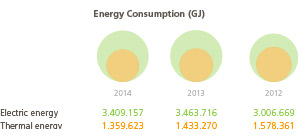
In 2014, the percentage of electricity used by Abengoa coming from renewable sources was 21 %.
A breakdown of this intermediate energy consumption according to renewable and non-renewable primary sources shows that most of the energy Abengoa uses comes from hydro, wind and biomass.

Measures adopted to reduce energy consumption
Another fundamental aspect of fulfilling Abengoa’s sustainability policies and objectives involves the implementation of measures to promote energy efficiency and emissions abatement in company operations and processes.
In 2014, Abengoa encouraged group companies to carry out initiatives aimed at achieving higher energy efficiency. Worthy of special mention among such undertakings were the measures adopted at the Solar Power One plant focused on enhanced focalization and reflectivity of the plant’s solar field, as well as improved steam turbine performance by means of an improved vacuum system, thereby achieving a reduction in the amount of natural gas used in the process. Investment in the initiative totaled € 90,000.
Also worth noting are the reductions in LNG consumption achieved at the Solucar, El Carpio, Castilla la Mancha, Extremadura and Écija solar plants in Spain. Overall reduction amounted to 38,379 tCO2eq.
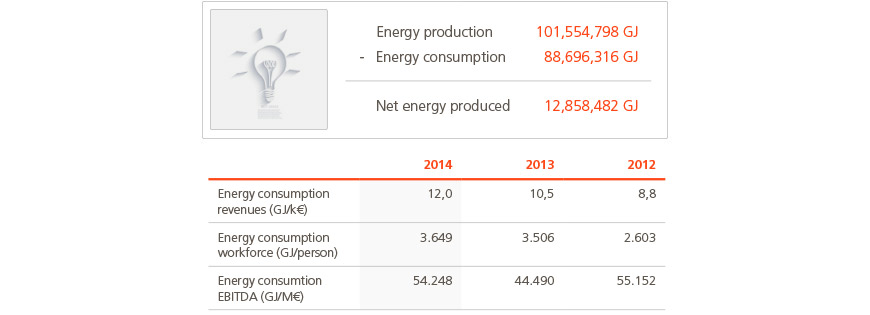
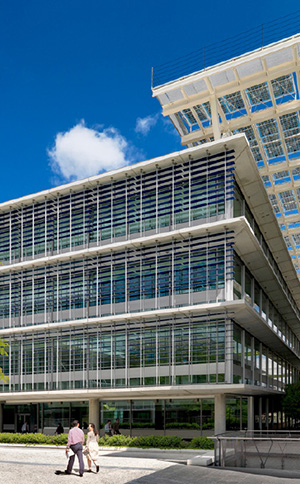
Efficient offices
Abengoa promotes energy efficiency in all of its areas of activity, which encompasses projects and company office locations and facilities as well. Along these lines, certification in three of its singular buildings: Campus Palmas Altas, Seville (Spain), Abengoa’s main headquarters housing 3,000 employees, has platinum LEED pre-certification: Castellana, 43, Madrid (Spain), with 700 employees, obtained its gold LEED certificate in 2013; and the corporate office in Rio de Janeiro (Brazil), with 600 employees, is currently in the process of obtaining silver LEED certification.
LEED (Leadership in Energy and Environmental Design) certification, based on a set of rating systems, is a U.S. assessment method applied to determine so-called green buildings by means of objective design guidelines and quantifiable parameters.
These certifications recognize the commitment undertaken by Abengoa to the environment and responsible management, in addition to the company’s engagement in the development of measures and initiatives that contribute to improving efficiency in conducting its activities.

Greenhouse gas emissions
Since 2008, Abengoa prepares its Inventory of Greenhouse Gases (GHG), management of which is handled through an internal application integrated into the ISMS (Integrated Sustainability Management System)13. The maturity of the system has enabled the company to draw up emissions reduction plans and develop CO2 labeling of the products and services it provides.

The Abengoa emissions management system is verified externally each year in accordance with ISO 1406414 . Standard specifications. The information provided below corresponds to the data included in the GHG emissions report verified by AENOR for 2014 15 .
Note 13 More information in «External Verification» chapter.
Note 14 ISO 14064: international environmental certification that lends credibility and assurance to reports on greenhouse gas emissions and reduction.
Note 15 More information in «External Verification» chapter.
Scope 1 emissions
With a breakdown by source type, shown below are the GHG emissions derived from Abengoa sources or those controlled by Abengoa, distinguishing between emissions associated with biomass and those linked to other productive processes.
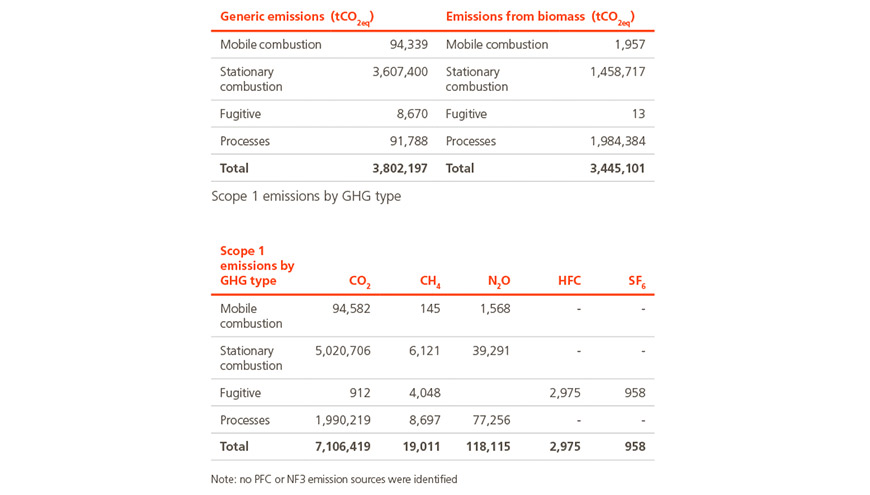
Scope 2 emissions
Emissions derived from the consumption of electricity and thermal energy, generated by other entities and purchased and consumed by Abengoa across company activities, were as follows:

Scope 3 emissions
Scope 3 emissions are indirect emissions resulting from company activities but which occur in sources that are not owned or controlled by the company.

The graph below shows the evolution of GHG emissions derived from Abengoa activity. A reduction trend can be observed as the consequence of the efficiency measures implemented in recent years:
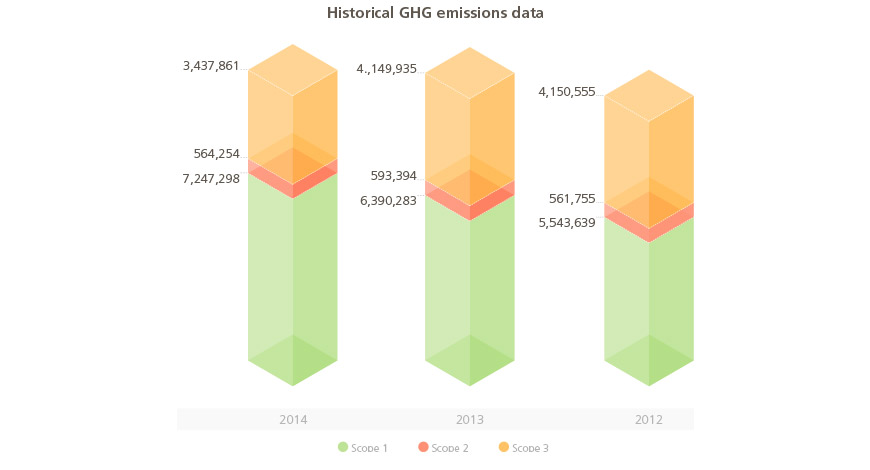
Historical GHG emissions data (tCO2eq)

The rise in GHG emissions was due primarily to the operational startup of the Tabasco cogeneration plant in Mexico, with a GHG inventory share of over 1.5 MtCO2eq. The increase in the GHG inventory in 2014 with respect to the 2013 inventory was 1.04 %.

CO2eq emissions due to biomass were as follows:

Emissions intensity
In order to objectively quantify the evolution of GHG emissions, Abengoa employs ratios, that is, by weighing emissions based on different indicators. Shown below is the evolution of emissions weighted with respect to revenues, EBITDA and employee headcount, over the past three years.

It is important to point out that Abengoa promotes the annual design of emissions reduction programs for all group companies. Since 2011, these reduction plans have been optimized and executed as directed actions in accordance with ISO 14064-1 requirements.
The most relevant initiatives carried out in 2014 were the following:
- Implementation of a CO2 capture system at bioethanol plant of Lacq (France) resulting in a reduction of 45,253 tCO2eq.
- Promotion of procurement with lower emissions in the value chain at the desalination of Accra (Ghan) Limited (Scope 3). This measure consisted of modification of the metal structure with respect to the original project by opting for a structure with a variable profile, thereby reducing the material needed to execute the structures envisaged under the project by 65%. The initiative rendered a reduction of 1,236 tCO2eq.
- Operational optimization aimed at reducing electricity consumption at the Helios I and II and Solacor I and II plants (Spain). Measures focused on changes in programming logic in terms of operation, startups and shutdowns and achieved a reduction of 2,446 tCO2eq.
In Abengoa contributed to the struggle against climate change with an emissions reduction totaling 459,658 tCO2eq achieved by optimizing productive processes, promoting CO2 capture systems and driving forward a reduction in CO2 emissions in the procurement value chain.
Carbon Disclousure Project
The company’s effort toward halting climate change was recognized by the Carbon Disclosure Project (CDP), the index which includes Abengoa among the 200 companies with the best performance in the struggle against climate change in the world (The A List), and among the components included in the Iberia 125 report, which includes the 125 largest listed companies in Spain and Portugal demonstrating a strategy of commitment to halting climate change. This year, Abengoa consolidated its leading position by obtaining a score of 99 A.

Other emissions
Having detailed knowledge on its emissions enables Abengoa to establish quantitative reduction targets by evaluating the progress and effectiveness of the measures implemented. Liste below are emissions other than CO2 and ozone layer-depleting substances.
The emissions recorded for NOx, SOx, CO, COVs and particles, according to weight, were the following:

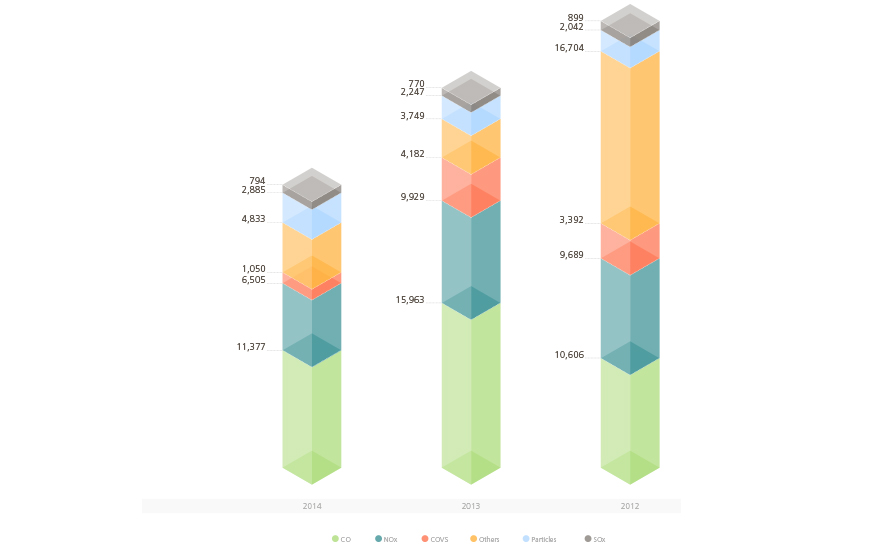
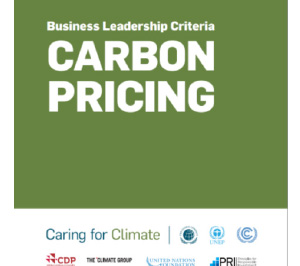
Putting price on CO2
The United Nations Global Compact (to which Abengoa has been signed up since 2002), the United Nations Framework Convention on Climate Change (UNFCCC)16 , the United Nations Environment Program (UNEP)17and Abengoa’s strategic Caring for Climate18 partners have driven forward an initiative aimed at putting a value on the cost of emissions as a necessary means to approaching climate change The Business Leadership Criteria on Carbon Pricing.
Abengoa signed the initiative on September 8, 2014 with the intention of gearing company activity toward a low-carbon economy. Upon doing so, the company undertook a set of commitments, among which are the following:
- Setting an internal price on carbon that is high enough to affect investment decisions and thereby reduce greenhouse gas emissions.
- Publicly advocating the importance of carbon pricing through policies that take into account the particular economic aspects and political contexts of each country.
- Reporting on progress in terms of the two aforementioned criteria in the information disclosed by the company.
These considerations are intended to contribute to reaching the goal of limiting the rise in average global temperature to 2°C above preindustrial levels
To this end, Abengoa has established an internal carbon price for the company of 9 €/tCO2eq. This price has been calculated using the volume and investment in emissions reduction initiatives, the volume and cost of carbon credits purchased and the cost of green energy acquired.
In addition, Abengoa has thereby undertaken a commitment to reducing its overall CO2 by 20 % in 2020 with respect to 2013 emissions levels. To do so, the company will allocate an annual economic volume resulting from the application of the internal price set to the 5 % of the total emissions from the annual GHG inventory.
Note 16 United Nations Framework Convention on Climate Change (UNFCCC):treaty which reflects international reaction to the effects of climate change and its consequences in terms of human activity. (+ info)
Note 17 United Nations Environment Program (UNEP): The voice of the environment under the United Nations system, this agency acts as catalyst, champion, educator and facilitator to promote sound use of resources and sustainable development worldwide. (+ info)
Note 18 Caring for Climate: an international initiative created by the United Nations Global Compact to advance the role of the business sector in addressing strategy for halting climate change. (+ info)
The amount of weight in tons of these atmospheric emissions has dropped by 36 % since 2012. The most significant cuts in 2014 were seen in CO y NOx due to increased use of biomass as a fuel in bioethanol production plants in Brazil. The drop in the emission of VOCs is the result of a change in computation methodology19.
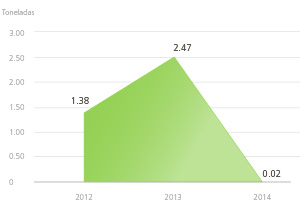
Despite the reduction in the use of these substances, amounting to 99,2 % rwith respect to 2013 and it is fundamentally associated with biofuel production activity, given that the number of reloads of systems containing these types of gases was reduced in 2014
Note 19 The IPCC emission factor was replaced with the U.S. Environmental Protection Agency (EPA) indicator at the ethanol production plant in Illinois.
